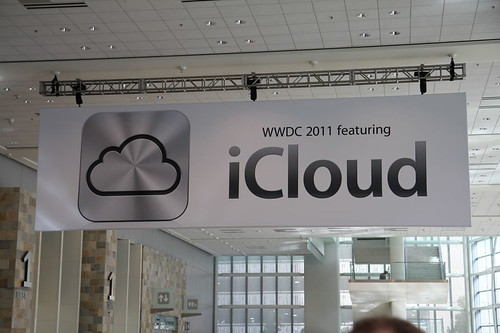Apple announced OS upgrades and new products at the Worldwide Developer Conference (WWDC) 2011 event yesterday. There was news about updates to the computer operating system – Mac OS X Lion – about the iPad and iPhone operating system – iOS 5 – and about a new service/product called iCloud. No new gadgets this time around.
Mac OS X Lion

Image Credit: BENM.AT
Out of 250 new features, Apple highlighted only some of them during the keynote. A major takeaway: you have access to everything everywhere all the time.
Trackpads will now respond to multitouch gestures including scroll, pinch and zoom.
A new control on the upper right will let you take an app full screen with a swipe, another swipe at the upper left will exit full screen.
Mission Control unifies Expose and Spaces. You can swipe to see all open apps and spaces. Another swipe takes you back to the desktop. If you’ve loved using Spaces, Mission Control will make it easier for you.
The Mac App Store is built in. That means you can buy software on your laptop with no trips to the store. Apps can be arranged and stored in folders like on iOS. When you launch an app, it takes you right back to where you were when you left off. Apple calls this feature Resume.
Auto-save is automatic in documents now. Plus versions of a document are saved as you work, which you can browse through with an interface that looks like Time Machine.
Tapping a document name opens up a contextual menu, including Browse All Versions. You can quit an app without saving, because Lion saves it for you.
AirDrop will appear in the Finder. Use it to drag and drop documents between computers in your network.
Mail is brand new. It looks like the version of Mail on an iPad and is optimized for reading. Search in mail can recognize if you are searching for a person, a subject or a date. The threading of mail is called “Conversation View” and appears in a separate column.
Lion is only available in the Mac App Store for only $29. It will be available in July. It looks like users currently running Leopard must first upgrade to Snow Leopard ($29) to gain access to the Mac App Store, so it will be a $60 fee to upgrade if you’re not already at Snow Leopard.
iOS 5 on iPhone and iPad

Image Credit: BENM.AT
Apple is calling iOS 5 a major release. There are 200 new features. The big ten were mentioned in the keynote.
Notifications will now be collected in a Notifications Center. They will be reachable without being so much of an interruption. If the screen is locked, they show. Swiping over a notification puts you into the relevant app, even from the locked screen.
Newstand will make it easier to get all your magazine subscriptions. Subscriptions will now be downloaded in the background.
Twitter will have a single sign-on across all your iOS apps. It’s integrated into apps like the Camera, too.
Safari will have a Reader feature and make it show just the story you’re reading. You can request full page and won’t have to tap from page to page. And you can email contents from what you’re reading rather than a link. That one may not be a big hit with web sites wanting traffic. Reading List lets you save stories to read later. A big one for me is that there is now tab browsing for Safari in iOS 5!
Reminders lets you store lists, dates, locations, todo items. It syncs with iCal.
Camera is faster and has a shortcut from a lockscreen, even if you have a passcode set. You can pinch to zoom in the camera. The camera can lock in auto expose and auto focus. You can edit right in the camera app – crop, rotate, red eye, etc.
Mail will add rich-text formatting, controled indentation, draggable addresses, and support for flagging. You’ll be able to search messages. There will be more support for S/MIME. There will be built in dictionary across all iOS apps, including Mail. You can split the keyboard to type with just your thumbs.
The new PC Free feature is a nice one. You can set up and activate the device without your PC. Software updates come straight to the device without being tethered to a computer. Updates shouldn’t take so long either, since they will only update what’s changed.
Game Center is more social. Games can be purchased and downloaded from Game Center.
iMessage is a new service between all iOS users. Messages can include text, photos, videos, contacts. You can see when the other person is typing. You can request delivery receipts and read receipts. iMessage pushes to all your iOS devices. Start with your iPod Touch and finish on your iPad. Messages don’t interrupt what you’re doing, they fade in and out without stopping things.
iOS 5 ships in the fall.
iCloud

Image Credit: BENM.AT
Steve Jobs handed off the speaking duties for the OS updates, but introduced iCloud himself.
iCloud lets you move your digital hub into the cloud where everything stays in sync between all your devices. Do something with one device, it gets sent to the cloud and pushed back down to all your other devices. It’s integrated with all apps – contacts, calendar, mail, App Store, iBooks, Documents, iWork (Pages, Numbers, Keynote), photos (using the Photo Stream app), iTunes. A change anywhere propagates everywhere. Including any new devices you buy as soon as you activate it. You’re limited to 10 devices.
There’s once a day backup to iCloud of all content.
iCloud is free. And it works for Macs and PCs.
The photo storage is only the last 1000 photos you’ve taken, so they have to be downloaded and stored somewhere outside iCloud if you have more than 1000.
There’s also a space limit in iTunes music.
To get iTunes in the cloud, just upgrade your phone to iOS 5. iTunes in the cloud will also run on iOS 4.3. It will be built in to all iOS 5 devices shipping in the fall.
You don’t have to buy the music from iTunes to use it on iTunes. iTunes Match can convert songs you’ve ripped from your CDs to the the Apple encoding (256 kbps AAC) and store them in the cloud. Jobs didn’t mention what the implications to the music industry might be of iTunes Match “legalizing” music you pirated or downloaded from some questionable source. The service is $24.99 a year no matter how many songs you have. And a sync is fast when compared with other services.
My Two Cents
Mac products continue to get better and better, and the cost of upgrading to the latest and greatest is not burdensome. The laptop is becoming a bit more iPad-like in operation while the iOS devices become more and more capable.
Their cloud service seems to be a better deal than the others available right now, or at least offers some stiff competition. If you’ve already got online backup storage in the cloud, iCloud might not provide the storage capacity you need to let it go. In iCloud’s favor, it is dead easy and syncs to all your devices automatically.
[Editors Note: Cross-posted at BlogHer.]



